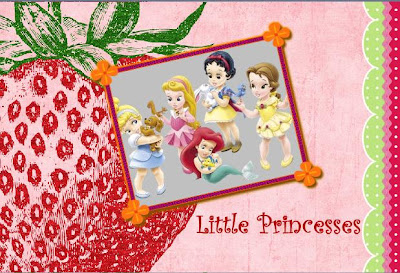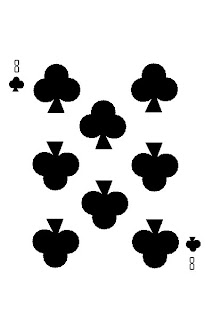
Tuesday, November 24, 2009
Scratch Challenge #2
Friday, November 20, 2009
Scratch Tutorials - Key-Moves
Tuesday, November 17, 2009
Scratch Tutorials - Whirl
Scrath Tutorials - Animate It, Change Colour, Glide and Follow The Mouse
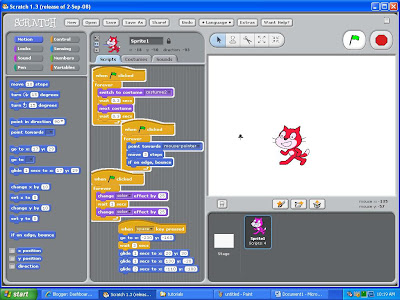
Friday, November 6, 2009
Scrath Challenge #1
Below is an example of what you can do on Scratch:

Monday, November 2, 2009
Sample flowcharts
Sunday, November 1, 2009
Windows 7

1. What versions is Windows 7 available in?
Windows 7 is available in Starter, Home Premium, Proffesional, Ulitmate, OEM and Enterprise.
2. Describe some of the features of the new taskbar:
Some of the features of the new taskbar include driver support, multitouch groundwork for the future, better battery management and easy-to-use interface.
3.What are jump lists and how will they be useful?
Jump lists are another new taskbar improvement that make recently opended documents easier to get to.
4. How can one quickly size two windows to fill the desktop side by side?
To size two windows to fill the desktop side by side, drag one window to the left edge and one to the right, and they wll automatically resize to fit the desktop.
5.Describe the 9 multitouch gestures that Windows 7 uses:
- Tap and double-tap
- Planning with Inertia
- Selection/Drag
- Press and tap with second finger
- Zoom
- Rotate
- Two-finger tap
- Press and hold
- Flicks
6. What is XP mode? What users would find this feature most useful? Would it be useful?
XP mode creates a virtual XP environment in which you can run older programs. This will be useful for businesses, as it doesn't have much of a practical application for the home consumer.
7. What feature related to to removable drives has Windows 7 removed in a bid to increase security?
To increase security, Windows 7 has removed AutoRun.
Friday, October 23, 2009
Definitions
- Algorithms - A step-by-step problem-solving procedure.
- Pseudo code - A high-level abstraction of code used to outline the steps in an algorithm.
- Machine language - A programming language designed for use on a specific class of computers.
- High Level Computer Language - Programming language with strong abstraction from the details of the computer.
- Flowchart - A diagram of the sequence of operations in a computer program.
Monday, August 17, 2009
Wireless broadband and Cable broadband
Wireless boradband is ten times faster than a dial-up connection plus it is completly independent of your phoneline. You connect via a small outdoor antenna to a network of small community-based radio repeater stations. Upload speeds are typically half the download speed and if the service uses a satellite feed to connect back to the internet there may be some limitations such as not being able to use video conferencing tools.
Cable broadband is broadband delivered via a cable and is only available for people with cable service in their area. Cable broadband is optic fibres that offer an excellent way of getting online, watching television and using the telephone.
http://www.ukbroadbandfinder.com/Broadband-Glossary-Definitions
http://www.hie.co.uk/broadband/broadband_facts.htm
Friday, August 14, 2009
SCRAPBLOG.COM
Tuesday, July 28, 2009
The World of Multimedia
It would be hard for people nowadays to live without a computer or mobile phone, and I believe that we would have a hard time finding information and communicating with friends and family. In my opinion, phones and computers will become more like a part of life in the future, and it will become harder for us to live without these.
The video on future directions seems pretty reliable to me. There are already some things that reminds me of those items in it. They are faster, easier and portable. I cannot see any any disadvantages in these future items.
Monday, July 27, 2009
Monday, June 29, 2009
RSS Feeds
RSS stands for Really Simple Syndication. It is a format that distributes news and other web content. A feed is when you put that content into RSS and send it to other people or websites.
2) What goes in the feed?
Audio, music, texts, videos and images. The feed contains a list of items that is identified by a link to the content on your site.
3) What can a feed do for you?
It allows you to see content without going to the website. Once you subscribe, the content comes to you.
4) How is a feeds different from email?
Feeds provide more information than an email. Emails are personal and meant for only you to read, however, a feed is not personal and can be read by anyone.
5) How do people read feeds?
To read RSS feeds, you send out the content and subscribers read it using newsreaders.
6) How do people find the feeds you want to subscribe to?
By using search-engines.
SYNOPSIS - Term 2 assessment
Monday, June 15, 2009
Broadband ?!
Broadbans is a type of data transmission in which a single medium can carry several channels at once. Broadband technology can transmit data, audio, and video all at once over long distances.
2. What units are used to measure bandwidth?
Bandwidth is measurred in megabits.
3. How much faster is broadband than dial up?
Broadband is about 40 times faster than dial up.
4. What are the speeds that broadband operates at compared to dial up?
A broadband connection transfers information at a rate of at least 2 megabits per second, a standard narrowband transfers info at the rate of 56 kilobits per second.
5. What are some of the advantages of using a broadband connection to download something like a video compared to dial up?
An advantage is that it provides tru media such as video, voice and data without the delay a narrowband incurs.
SYNOPSIS - Term 2 assessment
In this terms assignment we are asked to do a video on a topic of our choosing. Rena, Andy and I decided to do ours on chocolate... yeah, I know it's a weird topic, but we didn't have any better ideas. It's aimed at, well, everybody, and teaches us facts about chocolate that we might not have known about before.
We have included an intro, history of chocolate, Aztecs and their relation with chocolate, slave labour, Nutritional information, the states of chocolate and the outro.By the way, I'm doing history of chocolate and the outro :-)
Wednesday, June 10, 2009
Terms relating to audio files
Channel - A path over which electrical signals can pass.
Track - A song.
Frequency - The number of times a sound vibrates per unit of time. Frequency is expressed in hertz (Hz), a unit of measurement equal to one cycle per second.
Hertz - The hertz (symbol: Hz) is a measure of frequency, informally defined as the number of events occurring per second.
Decibel - The decibel (dB) is a logarithmic unit of measurement.
Wav, mp3, aiff - Wav is the file extension of an Audio for Windows sound file.
MPEG-1 Audio Layer 3, more commonly referred to as MP3, is a digital audio encoding format using a form of lossy data compression.
Aiff, or Audio Interchange File Format (AIFF) is an audio file format standard used for storing sound data for personal computers and other electronic audio devices.
Tuesday, June 9, 2009
AUDACITY MUSICVIDEO!!!
HELLO!!! Yeah, so this is my first blog for this term, hope you like it...
Oh yea, I'll tell you what I did later, if that's OK....
Monday, May 18, 2009
Buying A Scanner
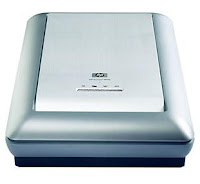
HP - Scanjet 4890 is capable of scanning, photocopying and printing high quality photo images. Comes in a sleek silver colour, solid and ready to use once the software's been loaded and the USB cable connected to the PC.
Its adjustable, robust, metal-hinged lid can accommodate large item. Using a built-in transparent materials adapter, the Scanjet 4890 can scan up to sixteen 35mm slides or 30 negative frames at once, as well as two to four medium-format film frames or one 4 x 5-inch film frame. There are four quick-start operational buttons on the front of the unit that will scan prints, scan film, e-mail, and copy, which makes life effortless for anyone who is computer shy and unsure of peripheral technology.
- Each scan takes around 10 seconds.
- Resolution is up to 4,800 x 9,600 dpi.
- The colour depth is 48-bit colour.
.
Sunday, May 10, 2009
Buying a DIGITAL CAMERA
This camera is what I need, when taking pictures at events with family or friends, because it has optical view finder, light weight, very sharp photos and fast and responsive to start-up and shoot, and so it is easy to take pictures with it.
 This Camera offers photographic performance and easy-to-use features and controls. 10 effective mega pixels, a 5x Zoom-NIKKOR lens, Optical Vibration Reduction, Image Stabilization technology, and 15 user-friendly scene modes, the COOLPIX S560 is the perfect camera for photographers looking for a compact, lightweight camera that is user-friendly with great creative power, and that is what I would like to have.
This Camera offers photographic performance and easy-to-use features and controls. 10 effective mega pixels, a 5x Zoom-NIKKOR lens, Optical Vibration Reduction, Image Stabilization technology, and 15 user-friendly scene modes, the COOLPIX S560 is the perfect camera for photographers looking for a compact, lightweight camera that is user-friendly with great creative power, and that is what I would like to have.
A card reader would be useful, because it can then be used as a USB, and that would make it easy to transfer images from the camera to the computer.
Image File Types
GIF files:
This is one of the most common image format. It encodes static bitmap images. In a bitmap image, the image file has to define the exact color of every pixel in the image. In a GIF image, the number of colors is reduced to 256 and then "runs" of same-color pixels are encoded in a color + number-Of-Pixels format. This makes a GIF file great for storing drawings that have lots of same-color pixels.
JPEG files:
This file is, like the GIF format, the most commonly used image format. It uses more complex techniques to compress images, where the colour of every pixel is different.
Animated GIF files:
An animated GIF file is a number of GIF files bonded together and displayed one after another. However, the size of the file is the sum of the GIF files used to create the sequence, and that can add up quickly.
MPEG files:
An MPEG file is like a JPEG file: it uses a complex algorithm like a JPEG file does, trying to eliminate repetition between frames to significantly compress video information. In addition it allows a soundtrack. Because a typical sequence has hundreds or thousands of frames, file sizes can still get quite large.
Shockwave files:
Shockwave files provides a vector-based animation capability. Instead of specifying the color of every pixel, a Shockwave file specifies the coordinates of shapes as well as the color of each shape. Shockwave files can be extremely small. They also provide soundtracks and animation. Because they are vector-based, you can enlarge the image and it will still look great.
What is a vector based image and how is it different to a bitmap based image?
Vector images are mathematically-based. All lines, shapes, etc. of a vector-based image are independent of one another.
Vector-based images are usually created and edited in "draw" or "illustrate" programs such as Adobe Illustrator. They have smooth edges and create curves or shapes. Vector-based images are good for precise illustrations, but are not as good for photorealistic images. They are easily scalable, due to their use of mathematic formulas.
Bitmap images, also referred to as raster images, are pixel-based. This means that location and color information about the image is stored in individual pixels within a grid.The information stored in a bitmap image regarding pixel location and color is what forms the image. Bitmap images are edited at the pixel level; in other words, the color of any one pixel can be changed.
Friday, April 3, 2009
Friday, March 27, 2009
ANIMATION ASSESMENT IN IST!!! DIARY ENTRY!!!
Our first IST assessment this year. We have to create an animation promoting our future house website. I'm in Coolock house, and I planned to make my animation on Gimp, because it's the easiest paint application for me. I want to do a clover walking to a party in Coolock house.
29/3/2009
Today I started making my animation. I saved it as a xcf file while making it. I made one image, then duplicated, then made another image, and so on when creating the animation. I saved my frames as Gimp formats. The frame rate was 100 milliseconds.
31/3/2009
I finished my animation today in class, but I still need to uploade it to my blog. I hope I'm gonna do it right!
3/4/2009
I tried to upload the animation to my blog, but it doesn't want to upload. It says something is wrong...
3/4/2009
Now I know why it didn't upload my animation! It was because it was a GIF image, and I needed a AIF image! Now it worked! Thanks to Serena and my dad of course, because I didn't know why it didn't want to upload... THANK YOU SO MUCH SERENA! and my dad of course :-)
Tuesday, March 17, 2009
Monday, March 16, 2009
Monday, March 9, 2009
Monday, March 2, 2009
GIMP TOOLS
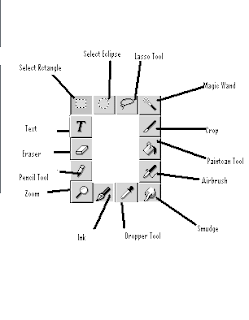
Tuesday, February 17, 2009
Dgital Art
Yes
· What are some of the advantages that digital paint and draw programs offer over the traditional methods (canvas and paint).
Background colours, frames, cut and paste, crop.
· What skills must a digital artist possess to create great digital art?
A digital artist must know what each different tool in a drawing program can do, and how to use the programs, to create great digital art.
Tuesday, February 3, 2009
Digital Media
Digital telvision, digital video, internet, video games, and World Wide Web (www)
· What number system is digital data based on? What two digits are used to code all digital data?
Digital data is based on Binary numbers. 0 and 1 are the two digits to code all digital data.
· What is a bit? What is a byte?
A bit is a single numeric value, either 1 or 0, a byte contains 8 bits.
· What is “sampling rate”? Find an image that explains how sampling works (Wikipedia is a good resource here…you can place these images in your blog)
A sampling rate is a grah that shows the amount of a sample per second.
courtsy of ww.en.wikipedia.org/wiki/Sampling_rate
· How does Colour Depth (Color Depth) or bit depth effect the appearance of an image? Find some images to illustrate the effect.
Colour depth affects the apperance of an image by altering the colour quality depending onthe amount of bytes or bits in that particular image. For example if you have one or two bits in an image you will only have a monochrome coloured image. Whereas is you have an image with more bytes you will get a better quailty image with 64 bytes being the largest so far.
· Colour depth effects both still and video digital media. Sampling rate only effects video but not still media. Can you explain.
Sampling rate only affects video as it takes the sample per second, a video is a moving image and therefore the sampling rate would take the images per second. However colour depth only affects still and video digital media. Nothing is produced in still images and therefore a sampling rate is not affected.









